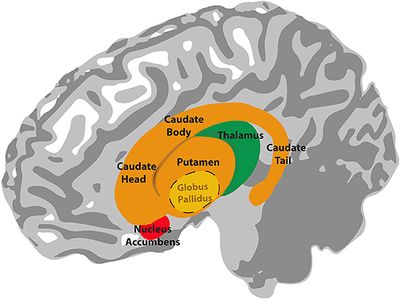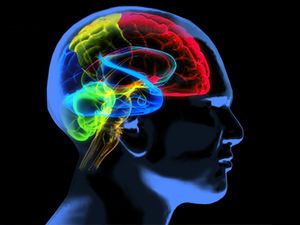The cerebrum of the central nervous system is the uppermost part of the brain. It is composed of the basal ganglia, cerebral cortex, and olfactory cortex. The cerebrum is divided into a left and right hemisphere on either side of a central fissure. As the largest part of the brain, the cerebrum sits in front and on top of the brainstem and behind that sits the cerebellum. It receives sensory information, processes it, regulates motor and conscious activity, and is responsible for a broad range of cognitive processes.
 |
| Cerebrum |
Overview
The cerebrum is the largest part of the brain. Its outer surface is covered by the cerebral cortex spread over five paired lobes: frontal lobe, parietal lobe, temporal lobe, occipital lobe, and (to a lesser degree) limbic lobe.
Cerebrum (Neuroanatomy) - The primary three parts of the cerebrum are the basal ganglia, cerebral cortex, and olfactory cortex (not the olfactory bulb).
- In terms of cerebrum vs cerebral cortex, the latter is part of the former; they are not the same structures.
- Like all vertebrate brains, the human brain develops from three sections known as the forebrain, midbrain and hindbrain. Each of these contains fluid-filled cavities called ventricles. The forebrain develops into the cerebrum and underlying structures; the midbrain becomes part of the brainstem; and the hindbrain gives rise to regions of the brainstem and the cerebellum.
Location
The cerebrum is located in the superior part of the cranial cavity inside the skull. It is divided by the longitudinal fissure (easily recognized when looking at the top surface of the brain) with each hemisphere linked by the corpus callosum.
Within the brain, this location is less apparent. The basal ganglia lie deep inside the cerebral cortex close to the midline and around the corpus callosum. The olfactory cortex sits under the basal ganglia.
Structure
The cerebrum is divided into right and left hemispheres that are connected by an arch of white matter called the corpus callosum. The cerebrum is contralaterally organized, which means that the right hemisphere controls and processes signals from the left side of the body, while the left hemisphere controls and processes signals from the right side of the body.
Although the left and right hemispheres do not function independently of one another, there are certain functions for which one hemisphere excels over the other. See table below.
4 Lobes of the Cerebrum
Frontal Lobe
- Located in front of the central sulcus.
- Concerned with reasoning, planning, parts of speech and movement (motor cortex), emotions, and problem-solving.
Parietal Lobe
- Located behind the central sulcus.
- Concerned with perception of stimuli such as touch, pressure, temperature and pain.
Temporal Lobe
- Located below the lateral fissure.
- Concerned with perception and recognition of auditory stimuli (hearing) and memory (hippocampus).
Occipital Lobe
- Located at the back of the brain, behind the parietal lobe and temporal lobe.
- Concerned with many aspects of vision.
Function
 |
| Cerebrum (Neuroanatomy) |
The cerebrum is the part of the brain responsible for your high functions, including:
- Determining intelligence
- Determining personality
- Thinking
- Reasoning
- Producing and understanding language
- Interpretation of sensory impulses
- Motor function
- Planning and organization
- Processing sensory information
Physiotherapy Relevance
The type and extent of the damage will vary based on its severity and where exactly in the brain it occurs. Damage can occur from incidents such as road trauma, traumatic brain injuries, stroke, or other neurodegenerative diseases that cause atrophy or damage in the brain tissue.Because the cerebrum makes up much of the brain and controls all voluntary actions, sustaining damage to this area may cause widespread and varying consequences. Essentially, any condition affecting the brain may cause dysfunction in one or more areas of the cerebrum.


0 Comments